Donald Johanson facts for kids
Quick facts for kids
Donald Johanson
|
|
|---|---|
 |
|
| Born |
Donald Carl Johanson
June 28, 1943 |
| Alma mater | University of Illinois at Urbana–Champaign University of Chicago |
| Known for | Discovery of a new hominid, Australopithecus afarensis ("Lucy") |
| Scientific career | |
| Fields | Paleoanthropology |
| Institutions | Arizona State University |
Donald Carl Johanson, born on June 28, 1943, is an American scientist who studies ancient humans. He is famous for finding the fossil of a very old human-like creature named "Lucy." Lucy was a female australopithecine, a type of early human ancestor. He found her in a place called the Afar Triangle in Hadar, Ethiopia.
Contents
Who is Donald Johanson?
Donald Johanson is a paleoanthropologist. This is a scientist who studies the history of humans and their ancestors by looking at fossils. He has spent many years searching for clues about how early humans lived.
Early Life and School
Donald Johanson was born in Chicago, Illinois. His parents were from Sweden. He went to college at the University of Illinois and then earned his master's and PhD degrees from the University of Chicago.
When he found Lucy, he was a professor at Case Western Reserve University. Later, in 1981, he started a place called the Institute of Human Origins in California. This institute helps scientists study human origins. In 1997, it moved to Arizona State University.
Discovering Lucy
One of Donald Johanson's most important discoveries was a fossil skeleton named "Lucy."
Finding Lucy in Ethiopia
Lucy was found on November 24, 1974, in Hadar, Ethiopia. Donald Johanson and his team were exploring the area. His student, Tom Gray, convinced him to go for a quick look. That's when Johanson saw a small piece of white fossilized bone. He immediately knew it was from an early human ancestor.
They ended up finding about 40 percent of the skeleton. This was an amazing discovery because it's rare to find so much of one ancient skeleton. A team member, Pamela Alderman, suggested naming her "Lucy." This was because the Beatles' song "Lucy in the Sky with Diamonds" was playing a lot that night.
What Lucy Taught Us
Lucy was a Australopithecus afarensis. She stood about three and a half feet tall. Scientists learned that Lucy walked upright on two legs. This is called bipedalism. This discovery helped prove that early human ancestors walked upright a very long time ago.
From Lucy's bones, scientists also learned that she likely ate plants. Her curved finger bones suggested she might have still spent some time in trees. At first, scientists thought Lucy was an older member of a different species. But after finding more skulls like hers, they decided she was a new species, Australopithecus afarensis.
Donald Johanson and Maitland A. Edey wrote a popular book about Lucy. It was called Lucy: The Beginnings of Humankind. This book helped many people learn about this important discovery.
The "First Family"
Another big find by Donald Johanson's team was called the "First Family."
What is the First Family?
In 1975, just a year after finding Lucy, Johanson's team found more fossils in Hadar. This collection of teeth and bones belonged to at least thirteen different early human ancestors. They are known as AL 333, or the "First Family."
These fossils are also believed to be from the species Australopithecus afarensis. They are estimated to be about 3.2 million years old. Finding so many individuals together suggested they might have lived in groups, like a family.
Awards and Recognition
Donald Johanson has received many awards for his important work.
- In 1976, he received the Golden Plate Award.
- In 1991, he was given the In Praise of Reason award.
- An asteroid, 52246 Donaldjohanson, was named after him. This asteroid is a target for the Lucy spacecraft mission.
See also
 In Spanish: Donald Johanson para niños
In Spanish: Donald Johanson para niños
- Australopithecus afarensis
- Dawn of Humanity (2015 PBS film)
- List of hominin fossils

